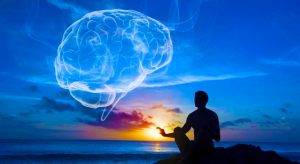Spirituality Activates the Brain Networks Underlying Other-Than-Self Attention
By John M. de Castro, Ph.D.
“Understanding the neural bases of spiritual experiences may help us better understand their roles in resilience and recovery from mental health and addictive disorders.” – Ephrat Livni
Spirituality is defined as “one’s personal affirmation of and relationship to a higher power or to the sacred.” It has been shown to have a myriad of benefits including recovery from addiction. In addition, spirituality alters the nervous system. It has been demonstrated that spirituality is associated with changes in the size, activity, and connectivity of the frontal and parietal lobes of the brain. So, spirituality and changes in neural systems co-occur. We may be better able to control addiction if we develop a more nuanced understanding of the changes in the brain that occur with spirituality.
In today’s Research News article “Spiritual experiences are related to engagement of a ventral frontotemporal functional brain network: Implications for prevention and treatment of behavioral and substance addictions.” (See summary below or view the full text of the study at: https://www.ncbi.nlm.nih.gov/pmc/articles/PMC7044576/ ) McClintock and colleagues recruited healthy adult, age 18 to 27 years, participants and scanned their brains with functional Magnetic Resonance Imaging (fMRI) while they were being guided toward images of either neutral, stressful, or spiritual imagery. Before and after testing they completed a measure of spirituality.
They found that during spiritual but not neutral or stressful imagery there was a significant increase in the activity of brain structures that constitute a ventral frontotemporal network, including middle and inferior frontal cortices, superior, middle and inferior temporal cortices, insula and frontal opercula, striatum, thalamus, brainstem, and cerebellum. The greater the increase in spirituality reported over the testing, the greater the increase in the activity of the ventral frontotemporal network. Hence, the more the imagery increased their spiritual feelings, the greater the response of the brain. They also found that there was a significant decrease in activity in areas of the brain that are components of the default mode network, including the middle and posterior cingulate and parietal cortex.
These findings suggest that the ventral frontotemporal network is activated during spiritual imagery while components of the default mode network are deactivated. The ventral frontotemporal network has been associated with attentional processing while the default mode network has been associated with self-referential thinking and mind wandering. It can be speculated that during spiritual imagery attention is focused away from the self. Regardless, the findings suggest that specific parts of the brain are involved in processing spiritual imagery.
So, spirituality activates the brain networks underlying other-than-self attention.
“it’s essential to examine how people experience spirituality in order to fully understand how their brains work.” – Lynne Blumberg
CMCS – Center for Mindfulness and Contemplative Studies
This and other Contemplative Studies posts are also available on Google+ https://plus.google.com/106784388191201299496/posts and on Twitter @MindfulResearch
Study Summary
McClintock, C. H., Worhunsky, P. D., Xu, J., Balodis, I. M., Sinha, R., Miller, L., & Potenza, M. N. (2019). Spiritual experiences are related to engagement of a ventral frontotemporal functional brain network: Implications for prevention and treatment of behavioral and substance addictions. Journal of behavioral addictions, 8(4), 678–691. https://doi.org/10.1556/2006.8.2019.71
Abstract
Background and aims
Spirituality is an important component of 12-step programs for behavioral and substance addictions and has been linked to recovery processes. Understanding the neural correlates of spiritual experiences may help to promote efforts to enhance recovery processes in behavioral addictions. We recently used general linear model (GLM) analyses of functional magnetic resonance imaging data to examine neural correlates of spiritual experiences, with findings implicating cortical and subcortical brain regions. Although informative, the GLM-based approach does not provide insight into brain circuits that may underlie spiritual experiences.
Methods
Spatial independent component analysis (sICA) was used to identify functional brain networks specifically linked to spiritual (vs. stressful or neutral-relaxing) conditions using a previously validated guided imagery task in 27 young adults.
Results
Using sICA, engagement of a ventral frontotemporal network was identified that was engaged at the onset and conclusion of the spiritual condition in a manner distinct from engagement during the stress or neutral-relaxing conditions. Degree of engagement correlated with subjective reports of spirituality in the scanner (r = .71, p < .001) and an out-of-the-magnet measure of spirituality (r = .48, p < .018).
Discussion and conclusion
The current findings suggest a distributed functional neural network associated with spiritual experiences and provide a foundation for investigating brain mechanisms underlying the role of spirituality in recovery from behavioral addictions.
https://www.ncbi.nlm.nih.gov/pmc/articles/PMC7044576/
